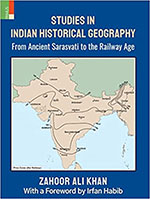Zahoor Ali Khan’s Studies in Indian Historical Geography: From Ancient Sarasvati to the Railway Age, a cartographic enquiry encompassing sixteen chapters, takes readers from historical-geography discourses on the river Sarasvati theories to map the impact of railways on the national markets. The book ends by mapping the uprising of 1857—offering a tribute to Kunwar Singh and his comrades. Professor Irfan Habib’s lucid foreword provides the context to the readers to engage with this important historical exercise.
Historical Geography is an attempt to understand the geographies of the past and its influence in shaping the geographies of the present and the future. Methodologies of historical geographies have undergone changes over time. Modern historical geography in the West owes its intellectual lineage to the studies on regional landscape formation by French geographers such as Paul Vidal de la Blache. Thereafter, historical research on landscape change has been a major focus of the endeavour. However, at a later stage historical geography emphasized cartography as a means to both interrogate and display the archive: by the use of historical sources to construct visually impressive and typically thematic maps. Zahoor Ali Khan’s work could be traced to this methodological paradigm. This paradigm was further challenged by the emergent historical materialism school and postmodernists.
The book is a product of Khan’s three decades long journey as a cartographer in the Department of History, Aligarh Muslim University. Such a long career has facilitated Khan’s encounter with abundant historical sources. Being trained as a geographer he used maps as a medium to translate his engagement with those historical sources. The book under review is not a ‘thick descriptive’ historical geography account but rather a compendium of inferences Khan makes from the rich sources he came across in his professional journey.

